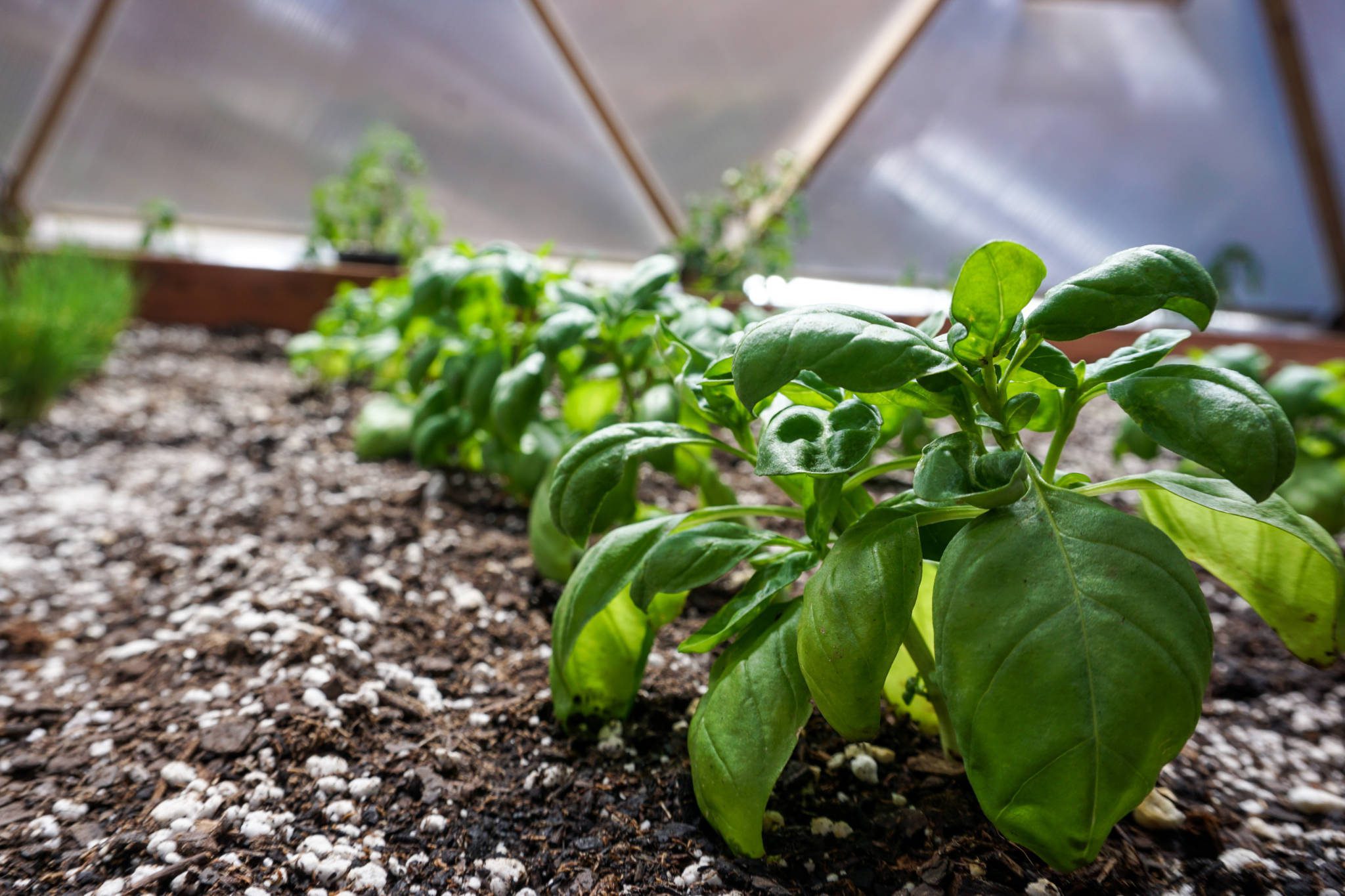
Featured Plant of the Month: Basil!
Growing basil in a greenhouse is a tricky balance. They don’t like things too hot or too cold, and while they repel some common pests, such as hornworms and flies, they are susceptible to problems like aphids and Japanese beetles. Let us teach you how to grow basil successfully in your greenhouse. With our expert advice, you will tip the scales in your favor.

See Organic Pest Management in a Growing Dome Greenhouse for pest control tips.
Fun Facts: Basil, or Ocimum basilicum, is an herb from the mint family, Lamiaceae, native to Africa and Southern India. Basil has been cultivated for at least 5,000 years. Nowadays, it plays a role in the cuisine of many cultures and kitchen gardens worldwide.
Planting Basil Seeds
Growing basil from seed is easy! This leafy plant prefers light, well-drained, and fertile soil that is no colder than 50 degrees. Basil plants love sunny sheltered spots, so they are right at home inside the Growing Dome. However, they will be happiest in a warm sunny spot. The frost date of basil is later in a Growing Dome, but too much cold will cause the leaves to blacken.
“With supplemental heat or near the north side of the dome, you may grow basil successfully all year. However, we will pull our basil out before winter.” – Growing Spaces Gardener, Desiree E.
For the best results, sow basil seeds in early spring for an early summer harvest or late summer for a fall harvest. Plant no deeper than ¼” and thin the seedlings once they have 2-3 leaves. After there are six “true” leaves, you can pinch off to above the second set to encourage your plant to start branching. More branches = more leaves!

Basil Companion Plants
Basil has many companion plants. It grows well with tomatoes, asparagus, parsnips, carrots, beet, turnips, chamomile, oregano, and chives. The dynamic duo of basil and asparagus attracts ladybugs, which is excellent for your greenhouse garden.
Another wonderful companion plant for basil is borage. Borage improves both the growth and taste of basil and adds a flare as a garnish with its beautiful flowers. Basil is also great with peppers. They love its insect-repelling properties, but it also provides dense ground cover, which helps trap the humidity that peppers love. When basil pairs up with marigolds, you double the pest-repellent aromatic shield, so mix in those marigolds!
Basil Varieties
Although there are over 60 types of basil, the most common varieties are sweet basil, bush basil, purple basil (not as sweet as sweet basil), Italian basil, lemon basil (lemon flavor), and Thai basil (licorice flavor).


How to Harvest Basil
Once it has reached 6-8″ tall, basil can be harvested throughout the growing season. The time to harvest basil is in the morning when the leaves are the juiciest! It’s best to harvest the leaves before the plant flowers as the leaves will dry and turn bitter after the plant flowers.
Even if you don’t need to harvest basil, picking some leaves every week is best to encourage growth. If you are picking leaves regularly, 12 plants can yield 4-6 cups of leaves per week! Basil can be stored by freezing or drying, but freezing basil will retain more flavor than drying it. If you find yourself with extra, we recommend making a donation to your local food hub.
Highly versatile herbs like basil are important plants to have in your garden. Basil is aromatic, which helps with pest control, and has medicinal properties. It is used in fragrant bouquets and as a garnish in many recipes, including ice cream!
My favorite way of using fresh basil leaves is in stuffed pasta shells, but I recommend trying some of our other popular recipes, such as Pesto Caprese Chicken or Vegan Lasagna.

If you are growing basil in your greenhouse, share a photo and your own advice with us in our Facebook Group.
Join the Inner Circle
An exclusive place for year-round gardeners. Join us to receive our monthly newsletter, “The Happy Grower”. In our newsletter we provide community stories, event updates, expert gardening tips, and exclusive offers.
